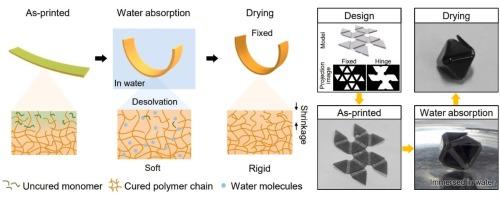Water-Responsive hydroplastic 4D printing with programmable shape morphing and locking
IF 7.9
2区 材料科学
Q1 MATERIALS SCIENCE, MULTIDISCIPLINARY
引用次数: 0
Abstract
Hydroplastic materials undergo reversible mechanical changes upon water absorption, transitioning between soft and rigid states. Leveraging this characteristic promotes environmentally friendly shape-morphing technologies, recently attracting significant research interest. This study aims to develop a method for inducing non-uniform curing along the thickness of a hydroplastic photocurable resin by applying frontal photopolymerization (FPP) using a commercial projector, and for achieving shape-morphing behavior through water absorption. The 3D-printed structures deform according to a predefined design, soften upon water absorption, and harden upon drying while retaining a stable deformed shape. Materials that deform in response to water or humidity are typically ductile, making it difficult to maintain their deformed shape after stimulus removal. However, this study demonstrates that a single material can programmable self-assembly while retaining its deformed shape even after water removal. This hydroplastic shape-morphing structure can be used for fabricating microfluidic channels on glass surfaces, which are difficult to process.

具有可编程形状变形和锁定的水响应水塑4D打印
水塑性材料在吸水后发生可逆的力学变化,在软态和刚性之间过渡。利用这一特性促进了环境友好的形状变形技术,最近引起了重大的研究兴趣。本研究旨在开发一种方法,通过使用商用投影仪应用正面光聚合(FPP),诱导水塑性光固化树脂沿厚度的不均匀固化,并通过吸水实现形状变形行为。3d打印的结构根据预先设计的变形,吸水后软化,干燥后硬化,同时保持稳定的变形形状。受水或湿度影响而变形的材料通常具有延展性,这使得在去除刺激后难以保持其变形形状。然而,这项研究表明,即使在除水后,单一材料也可以在保持其变形形状的同时进行可编程自组装。这种水塑性变形结构可用于在玻璃表面制造难以加工的微流控通道。
本文章由计算机程序翻译,如有差异,请以英文原文为准。
求助全文
约1分钟内获得全文
求助全文
来源期刊

Materials & Design
Engineering-Mechanical Engineering
CiteScore
14.30
自引率
7.10%
发文量
1028
审稿时长
85 days
期刊介绍:
Materials and Design is a multi-disciplinary journal that publishes original research reports, review articles, and express communications. The journal focuses on studying the structure and properties of inorganic and organic materials, advancements in synthesis, processing, characterization, and testing, the design of materials and engineering systems, and their applications in technology. It aims to bring together various aspects of materials science, engineering, physics, and chemistry.
The journal explores themes ranging from materials to design and aims to reveal the connections between natural and artificial materials, as well as experiment and modeling. Manuscripts submitted to Materials and Design should contain elements of discovery and surprise, as they often contribute new insights into the architecture and function of matter.
 求助内容:
求助内容: 应助结果提醒方式:
应助结果提醒方式:


